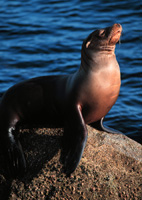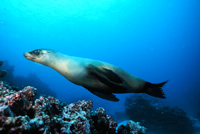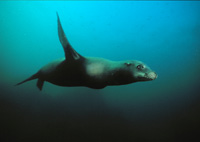California, Galapagos and
Japanese Sea Lions
(Zalophus californianus)
IUCN STATUS (2010): California sea lion - LEAST CONCERN
Japanese Sea Lion - EXTINCT
Galápagos Sea Lion - ENDANGERED
| Distribution and Numbers There are three subspecies of Zalophus californianus. The California sea lion (Z. c. californianus) is found from southern Mexico up to British Columbia and breeds almost entirely on islands in southern California, western Baja California and the Gulf of California. The Galapagos sea lion (Z. c. wollebaeki) is found on the Galapagos Islands and also occasionally in coastal Ecuador and Colombia. The Japanese sea lion (Z. c. japonicus) is now believed to be extinct but was formerly found in the Sea of Japan. Some scientists believe that these three subspecies should in fact be classed as separate species, namely Z. californianus, Z. wollebaeki, and Z. japonicus. It is estimated that there around 210,000 California sea lions in the United States and there are believed to be 31,000 in the Gulf of California. An estimate of 74,000 has been made for the western Baja California population but this estimate is considered unreliable, recent counts indicating that there are fewer sea lions than this. There is no up-to-date count of Galapagos sea lions, the last reported population estimate of 30,000 being made in the late 1970s. |
 Z.c. californianus Photo: Phillip Colla, Phillip Colla Wildlife Photography |
| Status California Sea Lion Extensive commercial killing of California sea lions for their blubber (for oil), hides and genitals was carried out in the 19th and early 20th centuries. Although the species was subsequently afforded some protection, sea lions continued to be hunted until the latter half of the 20th century in certain areas of California and Mexico for sport, pet food, hides and other uses. Large numbers were also captured for display. The species was protected in the United States in 1972 by the Marine Mammal Protection Act, and the killing of California sea lions has been banned in Mexico and Canada since 1969 and 1970 respectively. |
| Many of the prey species of California sea lions are also commercially fished, leading to widespread interactions between sea lions and some fisheries, and there is an increasing mortality of sea lions by entanglement in fishing nets and gear throughout their range. The major culprits are set and drift gillnet fisheries, but entanglement also occurs or has occurred in troll, purse seine, trawl, and commercial passenger fishing vessel hook and line fisheries. Available records show that the U.S. fisheries causing the highest mortality are the California set gillnet fishery for halibut and angel shark which kills an average of 1,012 sea lions each year, and the California driftnet fishery for sharks and swordfish which kills an average of 158 sea lions each year. Sea lions are also entangled in nets of the Mexican shark and swordfish drift gillnet fisheries. Some sea lions are released from nets by fishermen and others escape after being entangled, but the subsequent mortality rate of these escapees is unknown. |
| Some fishermen illegally shoot California sea lions and there are frequent reports of shot sea lions being washed up on shore. In January 1998, for example, more than a dozen sea lions, including several that were also decapitated, were found shot to death near San Francisco. United States stranding networks reported a total of 78 sea lions as having been found shot in 1998, 70 of which were dead. |
| There is currently a great deal of controversy in the United States surrounding plans to allow the selective killing of California sea lions which are being accused of endangering salmon and trout stocks in coastal Washington, Oregon and California. The State of Washington, currently authorised under special permit to kill sea lions in order to protect steelhead trout at the Ballard Locks, has not yet killed any sea lions, but in 1996 captured three of them and transported them to an aquarium. In 1999 the federal National Marine Fisheries Service released a report recommending that Congress allow, in the next reauthorisation of the Marine Mammal Protection Act, state and federal wildlife managers to kill California sea lions that are preying on endangered fish species. The report also recommended that authority be given to kill sea lions which pose a threat to public safety and property at locations such as docks and marinas, and that commercial fishermen be allowed to kill sea lions that destroy their catch or gear. Permission for fishermen to kill sea lions in this way was previously withdrawn in 1994. The report has been roundly condemned by animal welfare and conservation groups who argue that effective and humane non-lethal deterrence methods should be developed and that the problem of overfishing should be addressed. |
| There has also been controversy over the use of acoustic methods of deterring California sea lions from fisheries. In December 1999 the U.S. California Coastal Commission denied permission to the National Marine Fisheries Service to test a recently developed underwater acoustic scaring device. The device was designed to frighten California sea lions away from recreational sport fishermen by bombarding them with underwater noise and disorienting shock waves. Among various objections was that it could not be proved that the tests would not permanently harm sea lions and other marine life by causing serious injury, deafness, or even death. |
| The interaction of California sea lions and aquaculture installations in Canada is resulting in the deaths of a number of sea lions. It has been revealed that 133 California sea lions were legally killed under predator control permits by the British Columbia fish farming industry in 1999, mostly in the Vancouver Island area, and it is thought that other sea lions are also being illegally killed. In order to eliminate pinniped predation and reduce other environmental problems caused by fish farming, environmental organisations have been urging a move from open sea cage fish farms to land-based closed loop systems. |
| A number of California sea lions die as a result of being trapped in the water intake pipes of power plants, a total of 30 such sea lion mortalities being reported in the United States in 1998, but it is hoped that new grilles that have recently been developed will solve this problem. Many sea lions also die after being entangled in man-made debris, mostly monofilament gillnet material. A recent study near the city of La Paz in Mexico found that 3.9 - 7.9% of the sea lions were entangled or showed evidence of previous entanglement. Collision with boats is another cause of mortality. Several Northwest Indian tribes are planning to start the ceremonial and subsistence killing of California sea lions, one tribe having reportedly made plans for a commercial hunt of the species. |
| The species can be badly affected by the lack of food caused by El Nino events and there were major reductions in the number of California sea lion pups produced during the 1983-84, 1992-93 and 1997-98 El Ninos, pup production falling by 64% in the United States in 1998. The population in the Gulf of California however showed no evidence of increased mortality during the 1997-98 event. In May 1998 nearly 80 California sea lions were washed up in the Monterey area of California suffering from seizures and vomiting, more than 50 dying as a result. Subsequent analysis showed that the cause was a domoic acid toxin from a harmful algal bloom that was concentrated in anchovies and other small marine species eaten by the sea lions. A resultant study of the mortality stated that domoic acid poisoning could also explain other sea lion die-offs in 1978, 1986, 1988 and 1992. An unusually high total of 150 dead California sea lions were reported as having been washed up in California's Ventura County from May-June 2000. A Californian stranding centre also reported in August 2000 that since mid-June it had taken in at least 135 California sea lions exhibiting symptoms indicative of domoic acid poisoning, mostly adult females from San Luis Obispo County, and that over 50 of these had died. There are also occasional outbreaks in the population of the bacterial disease leptospirosis, which not only causes death and debilitation but can also cause reproductive failure in females. |
| Pollution is still seen as a threat to California sea lion populations and may have been the cause of the mass mortality of over 200 sea lions that took place near the island of San Jorge in the northern part of the Mexican Gulf of California in February 1999. An official with the Mexican Environment Ministry in Baja California Sur stated that the mortality may have been caused by Natural Killer 19, a fluorescent chemical containing cyanide which is used by drug smugglers to mark drop-off points in the water. |
 Z.c. wollebaeki Photo: Phillip Colla, Phillip Colla Wildlife Photography |
Galapagos Sea Lion The Galapagos sea lion is listed as Endangered on the IUCN Red List. This subspecies was not subjected to the same commercial exploitation that caused the depletion of California sea lion populations, although occasional sea lions were killed for their skins or to provide tooth necklaces for tourists. Many Galapagos sea lions have been and are still being killed as a result of illegal and local fishing activities around the islands, despite the Ecuador government expanding the no-fishing zone around the islands from 15 to 40 nautical miles in early 1998. The entanglement of sea lions in fishing gear, particularly in long-line hooks and nylon line, is one of the most important problems currently affecting the subspecies. Entanglement in marine debris is an additional problem. Between 1995 and November 2000 a total of 111 reports of entangled sea lions were received. |
| Sea lions and other wildlife were oiled when the tanker Jessica ran aground on the island of San Cristabal in January 2001 due to a navigational error. An estimated excess of 600,000 litres of oil escaped from the tanker and reached a number of other islands. At least 26 oiled sea lion pups were collected and washed on-site on Santa Fe and San Cristobal. In addition approximately 50 pups and two juveniles on San Cristobal were reported to have eye infections and one sea lion was spotted there with a diesel burn. A small number of sea lions on San Cristobal were relocated in order to minimise their chances of being affected by the oil. In March 2001 a heavily oiled sea lion was found dead on the island of Floreana, the death of which appeared to have been caused by the oil spill. Systematic evaluation is being carried out to determine the long-term affects of the spill, and calls have been made to restrict tanker traffic around the islands. |
| Galapagos sea lions are badly affected by the lack of food availability and weather conditions produced by El Nino events. During the 1982-83 El Nino all Galapagos sea lion pups born in 1982 died, while only a third of the normal number of pups were born in 1983. During the 1997-98 El Nino, the Galapagos sea lion population showed a significant decline in almost all of its colonies, a 48% population decrease caused by both mortality and migration having been observed during this period. The most affected age range were pups born between June 1997 and December 1998, suffering a 90% mortality rate. The large male sea lions, especially the dominant sea lions during the 1998 breeding season, experienced a 67% mortality rate. During the El Nino event it was found that the sea lions tried to make up for the lack in prey by feeding on lantern fish (Myctophidae) rather than the usual sardines (Clupeidae), and exhibited behavioural changes such as foraging during the night. The mortality rates indicate however that this modification in foraging behaviour was not enough to protect the population from the effects of the event. A recovery in the Galapagos sea lion population has been observed during 1999 and 2000, with an estimated 10% increase in the population. Pups born during the 1999-2000 breeding season were observed to be in good condition. |
| Japanese Sea Lion There have been no reports of this subspecies for over 30 years and the Japanese sea lion is now listed as Extinct on the IUCN Red List. Only limited details are available of the former distribution of the subspecies and of the nature of its relationship with California and Galapagos sea lions. |
| Lifestyle California Sea Lion The breeding season for California sea lions lasts from May - July. The adult males arrive at the start of the season in order to establish territories on rocky, gravel or sand beaches where a number of females haul out to give birth. Females usually give birth 4-5 days after coming ashore. Pups are born from mid-June to mid-July with a dark brown to black coat that they will moult for a lighter brown colour within a month, and will moult again after 5-6 months for a coat very like that of the adult female. The mother nurses her pup for about 8 days before leaving to feed at sea, beginning a cycle of alternately feeding at sea for 2-4 days, usually within 100km of the rookery, and nursing her pup on shore for about 1-3 days. About 3-4 weeks after her pup is born, the mother mates with a territorial male, usually in the water or at the water's edge. Territorial males can mate with many females. Nursing lasts 4-8 months although some mothers have been observed nursing their pup for over a year. |
| After the breeding season the male adults and subadults migrate northwards to feed and winter along the coasts of California, Oregon, Washington and British Columbia, eventually returning south to the rookeries from March - May. Many of the males from Baja California spend the winter in California. The females are thought to stay near the rookeries all year round. Adult females and immature sea lions moult from August - October, adult males from November - February. The female sea lions have a light brown coat, while adult males generally have a dark greyish brown to black coat as well as a recognisable crest on their forehead that they develop during puberty. |
| California sea lions generally feed on prey that school or form dense aggregations, diverging from this feeding pattern when their normal prey is not as abundant or not available, as happens for example during moderate and severe El Nino events. Normal prey for California sea lions includes anchovies, sardine, whiting, mackerel, rockfish and market squid. While feeding, individuals dive for short periods of about 2 minutes to the relatively shallow depths of 26-74m. California sea lions have also been observed feeding on chicks of the common murre. Sharks and killer whales are known predators. |
| Galapagos Sea Lion The Galapagos sea lion has a very similar description and lifestyle to the California sea lion as outlined above. Pups are born and breeding takes place on the sandy and rocky beaches of the Galaagos Islands from May - January, the timing varying from island to island. About 4-7 days after her pup is born, the mother leaves to feed at sea, thus beginning a cycle of feeding during the day, mainly at depths of 20-60m, and returning most nights to feed her pup. The pup can be nursed for as little as 6 months, but is often nursed for a year until the next pup is born. Some mothers have been known to nurse both their new pup and old pup for periods of up to a year. It is also occasionally known for mothers to nurse a single pup for up to 3 years, as long as they do not give birth to a new pup during this period. Galapagos sea lions do not migrate, remaining around the islands all year and feeding at shallow depths, mainly for sardines. |
| Statistics Adult male California sea lions measure up to 2.4m in length and weigh an average of 275kg (maximum 390kg), while adult females measure an average of 1.8m (maximum 2m) in length and weigh an average of 80-91kg (maximum 110kg). Galapagos sea lions are generally smaller in size than California sea lions. Pups of the species measure about 70-80cm and weigh 6-9kg at birth, male pups being born heavier than female pups. Both males and females of the species reach sexual maturity at about 4-5 years of age, but males may not achieve territorial status until approximately 8-9 years of age. A California sea lion was observed diving to a depth of 376m, and the longest dive yet recorded was for 8 minutes. It is thought that members of both subspecies can live for 15-24 years. |
 Z.c. californianus Photo: Phillip Colla, Phillip Colla Wildlife Photography |
